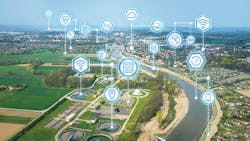With all the attention being given to the climate change aspects of sustainability, it’s sometimes easy to overlook the growing importance of sustainability when it comes to conserving the world’s increasingly constrained supplies of fresh water. Indeed, industry is among the largest consumer of fresh water, and many global manufacturers have identified water scarcity as a significant risk factor to continuing operations. To answer the challenge, operators of both municipal and industrial water and wastewater treatments systems are in the midst of their own transformations—from often vulnerable, run-to-fail operations to smarter, optimized systems driven by the effective integration and analysis of data from the field on up.
To discuss this ongoing transformation of our water/wastewater infrastructure, Control caught up with Nick Hanson, national industry marketing manager for the water/wastewater industry at Endress+Hauser in the United States.
Q: As a leader in the process instrumentation marketplace, what opportunities is Endress+Hauser seeing in the water/wastewater industry?
Q: Beyond measuring and controlling flow rates and tank levels, the use of analytical instrumentation to verify water quality is an important function of water/wastewater instrumentation that seems to be constantly evolving. Are more analytical techniques moving online (vs. sampling) and are there additional analytical methods being required by new regulations?
A: There’s a saying that you can’t control what you don’t measure, which I think really hits home. Not just because it makes sense, but because it refocuses the conversation on the importance of data accuracy and availability. So, yes, more liquid analysis measurements are going online. As more regional and national regulations get handed out, our customers need those measurements to be timely and accurate, and they want to “own” that measurement directly, rather than outsourcing to a third-party lab. Online measurement not only improves reporting accuracy and consistency, but also lets operators react more quickly to any upsets in the processes and make corrective adjustments on the fly. Making sure that our customers have the best instrumentation and the best data possible goes a long way.
Q: As a response to the COVID pandemic, it seems like all industry sectors are focused on improving the remote accessibility of data and systems. Has it been any different for the water/wastewater sector?
A: I think the water/wastewater sector has been equally impacted by the pandemic. It’s really changed the landscape of our workforce. Organizations were forced to make do with minimal onsite staff in order to minimize contact among employees. More automation, better data and the ability to troubleshoot remotely have been common themes. When the individual with the necessary expertise can't be onsite or travel to a remote lift station, the ability to remotely troubleshoot and diagnose problems is needed.
The move to more modular water/wastewater treatment system designs already had us traveling this path; the pandemic just accelerated that transformation.
Q: How is Endress+Hauser making it easier for its water/wastewater customers to access, understand and make better decisions based on the data in its instruments?
A: Diagnostic information from field-level devices has been there a long time, but it has often gone unutilized. From a practical perspective, that data had to be piped up through the local control system, and that put a heavy burden on the programmable logical controller (PLC) or distributed control system (DCS). And, once that data made it up through the control system, you needed a proper historian to store it, plus the application to turn that raw data into useful information.
More recently, however, a combination of diagnostic tools and communications capability such as those embodied in Endress+Hauser’s Heartbeat Technology began to liberate that data and put it to good use. With our Netilion IIoT ecosystem, for example, we bring all that secondary instrumentation data directly into our system, where we crunch all those diagnostics in real time, producing predictive maintenance alerts and real-time alarms if a problem is detected. It can provide a global view of all devices at a site or plant level. Interest in Netilion has really taken off; the pandemic really opened everyone's eyes to the possibilities of leveraging a remote, secondary environment to complement our current systems.
Q: Is Netilion purely cloud-based, or can it be implemented as a local solution as well?
A: We have customers using Netilion both ways. Data from our instruments and from those of other manufacturers can be extracted from field-level networks, and sent to the cloud via a secure cellular gateway in a local switch, or routed to a local server for on-premises analysis. In both scenarios, we adhere to all the latest standards related to cybersecurity.
Q: What other areas of sustainability improvement are available to industrial users of water, and how is Endress+Hauser driving innovation in this area?
A: The topics of water, wastewater and sustainability go hand in hand. For local producers of water, having an efficient, optimized process impacts sustainability as well their bottom line. On the flip side, industrial consumers of water need to be mindful of the source of their water. Many Western States are in the midst of historic droughts, with multiple reservoirs and bodies of water at historically low levels. In other parts of the country, flooding has taken out more than one municipal treatment facility. And, while that’s technically a surplus of water, such events disrupt the whole infrastructure of clean drinking water production. So, on the topic of sustainability, not only do we have to be mindful of our own businesses, we also need to be mindful of the environment.
At Endress+Hauser, we impact that equation through reliable and accurate measurements. We provide the information that allows users and OEMs to make their processes as efficient as possible. When processes don’t shut down unexpectedly and when operators can quickly respond to upsets, they tend to be more efficient, too. We're not directly responsible for producing large quantities of water in nature, but we like to say that we're pretty good at conserving them.


